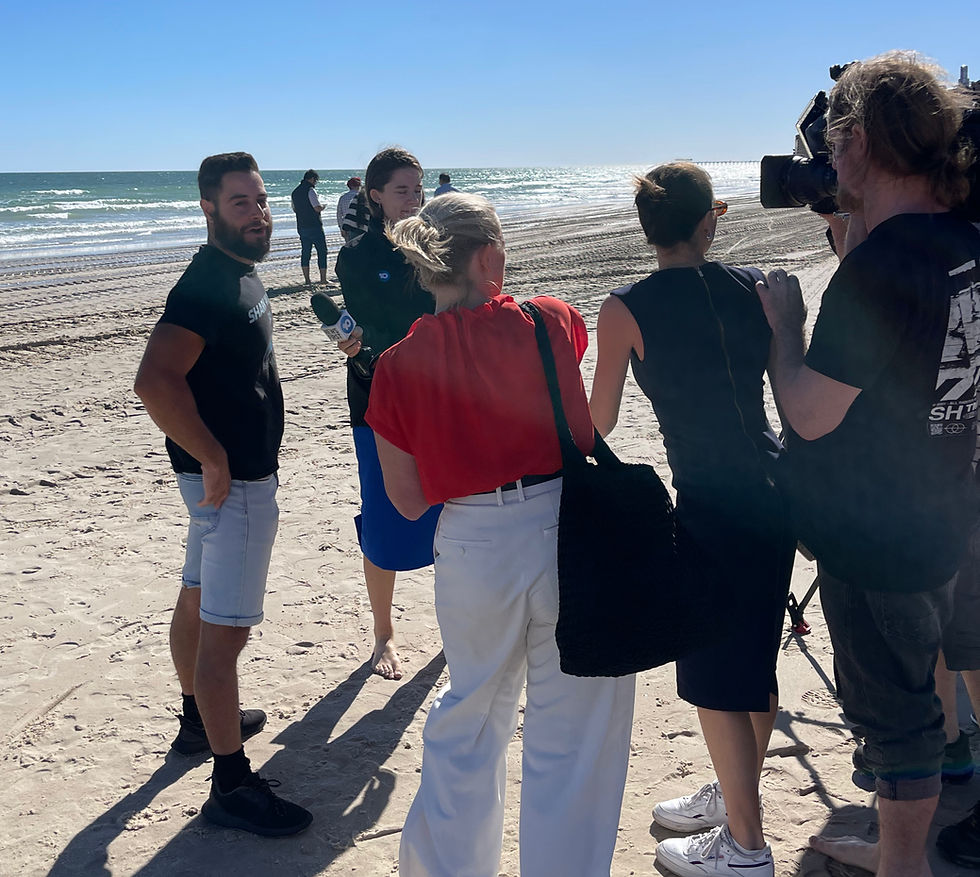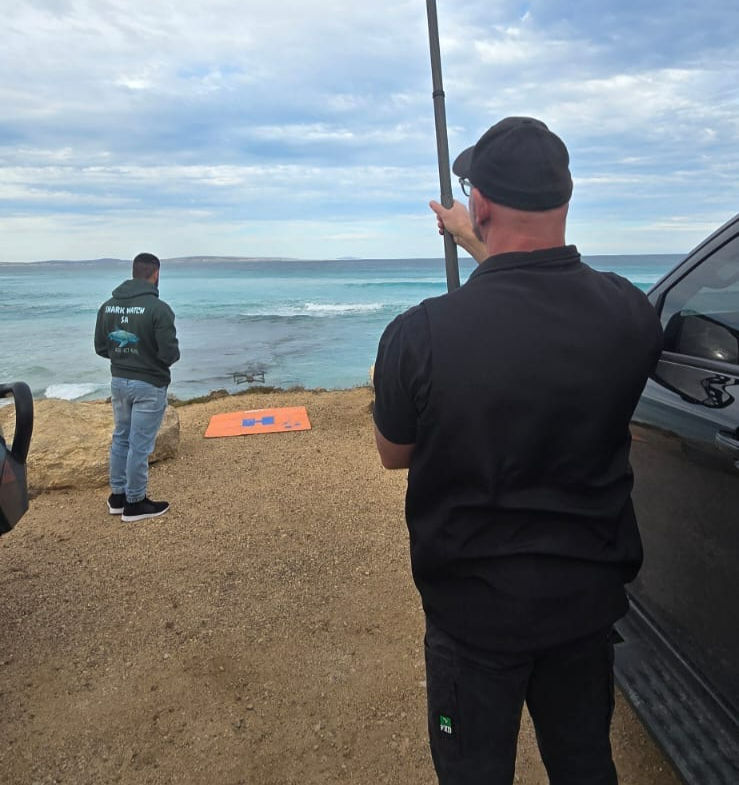Walking the Gauntlet of Purpose & Reputation - The Tightrope of Directing a High Demand Service on Your Own
- Shark Watch South Australia

- Jul 22
- 8 min read

Part 1 – Shifting Cultural Practices for how we Manage Shark Sightings
In early spring of 2016, Shark Watch rapidly began to gain traction, as the states leading depository for state-wide shark sightings. This was unprecedented for several reasons. Firstly, because many documented photographs or video footage of SA shark encounters are only shared among a small circle of family and friends and nowhere else. Some documentations only make it to the news for seldom coverage on rainy days when limited news stories are available or when the media needs hype to promote the typical sensationalist narratives around spring/summer time to evoke fear among the general population. Some become wasted space in iPhones while others are shared to PIRSA Fishwatch officers or other local surf rescue agencies who don’t have a protocol in place for public correspondents when it comes to this matter. The bottom line is that the delegation of shark sighting reports in SA lacked effective practices for distributing the information in a way that could potentially save a life or be stored for anecdotal research purposes. A central data sharing point of this nature was virtually non-existent.
Shark Watch literally changed the culture for empirical shark monitoring within the state of South Australia in the timespan of a year. Suddenly, all offshore water users no matter what demographic they were (recreational or commercial) now have a chance to share their testimonies and encounter footage on a platform made especially for them!
“Yeah, but it’s just a shark swimming in the sea… what’s the big deal?” The reason this became so monumental, is because most city based South Aussies have very little knowledge about the population activity of local sharks. This is generally because certain data related to migratory behaviour and human interaction, is not easily accessible, or rarely studied enough. This makes this type of empirical data hard to source on a central public domain. Second to this, South Australians who are demographically raised in the suburbs, or country region, wouldn’t typically devote as much time to being on and around the water enough to become affiliated with local fishers and their coastal and offshore surroundings in comparison to coastal residents, which in turn makes them have less experience around marine life to examine their behaviour, and make more accurate assumptions associated with this species.
So when an explosion of photographic sighting documentations suddenly became widely available on social media with the arrival of the Shark Watch sites, this revealed a major number of potentially dangerous species roaming Adelaide’s metropolitan coastline at any one time, and exposed an inadequate standard for shark surveillance and bite mitigation for the state. This was due to the amplification of empirical photographic evidence that would have otherwise gone un-noticed without the convenience of the Shark Watch SA depository.
Suddenly, big state government agencies were placed into a position to justify a concerning number of empirical shark observations close to Adelaide’s metropolitan beaches with genuine science and research that is otherwise traditionally hidden away behind pages 2 and 3 on Google, and not conveniently available within the user friendly confines of social media. Put simply, state shark attack mitigation measures employ outdated strategies that utilise little to no resources in order to inform the public about the immediate localised threat of a shark to beachgoers. It also became quite clear that Shark Watch had turned into a major citizen science project allowing the community to photographically report and monitor sharks within their residential seaside townships. Essentially, it became a useful and highly personal asset that people can use at the convenience of their own fingertips, thanks to the growing population of local shark spotters who contribute their sightings on this platform.
Part 2 – Here Comes the Accountability!
Just as quickly as I had pronounced a new revolutionary way for how shark sightings were managed in the state, by sharing photographic evidence for the safety and education of others rather than being wasted due to lack of incentive, suddenly, I also had a mounting degree of accountability growing on my shoulders. You see, Shark Watch was designed and articulated to display a visual representation of professionalism and credibility. Professional, in the sense that the information was published in an organised and formal way with little character or expression (visually appearing as if a number of “nerdy experts” are managing the data). And credible, because the third person language and overall design layout of the social media sites appear as if a team of representatives are compiling readily accessible information.
As a seventeen year old who barely graduated from grade twelve with little knowledge of shark biology (all I really had going for me was a bunch of National Geographic and Shark Week documentaries and some basic Google searches), this couldn’t be any further from the truth! This meant that when the big questions were thrown to “Mr Shark Man”, in the way of false reports including misinformation about shark species that aren’t even found in South Australian waters, fake sightings for the amusement of others, and lack of discernment and logical reasoning to justify the “fishy tales of boastful fishermen”, I began to realise that some protocols needed to be implemented, and a level of humility had to keep me in a sponge like state to keep growing in knowledge at a fast rate to match the professional identity which I had portrayed for myself through the Shark Watch image.
You can’t fake anything. The truth will eventually come out. Sure, I expected that one day I would have quite the following behind Shark Watch, but what I didn’t prepare for was the unprecedented media publicity and the local acceptance for the platform I was providing. Big publicity means big responsibility. If there’s one thing I would have changed from the beginning, it would have been my selfish demeanour that prevented me from being more open to working with others in the community and taking on my dream with more vigour. Ultimately Shark Watch became an expression of my creative side, but it lacked true knowledge that could only come from decades of scientific research from being out in the field and conducting extensive experiments alongside a highly qualified team of marine biologists.

Ultimately, I was missing the most important lesson of all. The reason why Shark Watch became so popular in a very short amount of time was because of its operating structure which output and effectiveness is entirely dependent on the input of others. Shark Watch expands, as its following grows. As the body expands, so does the work output and the efficacy of reporting. The more contributors who are readily available at any one time to report shark sightings from around the state, the more effective it becomes at warning others and mitigating the active threat of a shark attack.
It’s a simple business strategy which requires little marketing. Behind all the media publicity and viral footage, we must also acknowledge the universal “law” behind this outcome that became the most pivotal force to the success of Shark Watch. Unification, alliance, and love and consideration for others. A non-discriminatory and universal law that naturally facilitates the preservation of life. Shark Watch applies this law through unimpeded networking with the community via a conveniently diverse network of contact points and open and transparent reporting. The data is empirical, raw, concise, and can be readily obtained. Its participants do not have to be qualified with a marine biology background, nor are they confined to a particular group or organisation specialising in the field of shark research. It is an interactive public depository allowing the community to better understand the relationships sharks have with humans and their watercraft and their distribution in South Australia. The community can now associate positive experiences from genuine accounts and become more familiar with sharks in South Australian waters without fear from uncertainty and false perceptions due to lack of exposure due to authentic shark reporting.
This is what South Australia needed. When we analyse the scope of groups comprised of different offshore water communities, we can see why the Shark Watch service and its principal operating structure (the universal law of collaboration) systematically work well, as these communities are comprised of a broad and mixed demographic of well-connected surfing and diving communities, kayak and sailing communities, and coastal fishing and leisure communities. By formalising an interconnected user base as a place where all of these communities can retrieve timely shark sighting information at the tip of their fingers, this invites a collaborative and non-invasive citizen science and risk mitigation project which doesn’t require costly and timely political decisions that lack cohesiveness in delivering consistent and effective solutions for state shark bite prevention.

If Shark Watch continued operating in the same non-collaborative state it was previously in prior to the 2025 commencement date, I’m confident we wouldn’t have invited the same amount of attention and positivity among the greater South Australian population, as previously experienced in the earlier 2016 days when collaboration was something I wasn’t pursuing. Shark Watch would probably have fallen under the same category as most other independent shark reporting projects in the state that ultimately lack character and vigour which comes from rapid and expansive community networking. The window of opportunity is now firmly in place. There is no more hiding behind a logo, or relying on the façade of social media to determine the capability of Shark Watch. The discrepancies in collaborative efforts between state government and community bodies is becoming increasingly evident, and this reveals a gap in unification that Shark Watch is now fully exploiting by banding together with a diverse body of citizens who all have unique skills, equipment, and knowledge when it comes to our offshore waters.

The final word, if you have a citizen science project that’s valued by others, and has the ability to become an innovative solution to one of life’s many problems, why hide behind your websites when you can be out taking accountability for your work and inspire others to replicate a similar pursuit in their own field of interest? Taking accountability meant teaming up with others who had more knowledge than me to fix my own incompetence. Taking accountability meant being an example of the very work I was trying to promote, in meeting face to face with my contributors to create a masterpiece of wonderful works in the likeness of drone photography and remarkable video documentaries. Taking accountability meant pushing myself out of my comfort zone into the media spotlight, getting around environments of unfamiliarity, putting away distractions and making sacrifices in order to grow out of ego fuelled gratification and walk in true fulfilment by embarking on an exciting and challenging life pursuit!





Comments